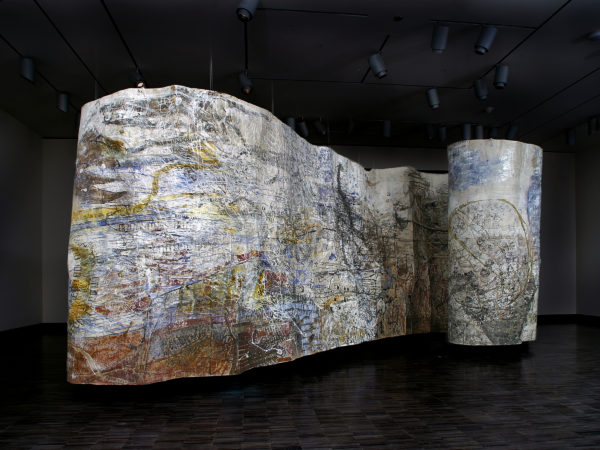Activity
A Kaleidoscope of Flowers
Objectives: Students will
- Examine the Hindu tradition of pookolam—a three-dimensional threshold art using flowers;
- Research the harvest festival of Onam celebrated in the southwestern state of Kerala, India;
- Create an auspicious flower decoration in celebration of Onam

A pookolam
Common Core Standards
MD 4.6: Measure angles in whole-number degrees using a protractor. Sketch angles of specified measure. G 4.3: Recognize a line of symmetry for a two-dimensional figure as a line across the figure such that the figure can be folded along the line into matching parts. Identify line-symmetric figures and draw lines of symmetry.
Materials
Map of India; variety of flowers, lentils in a diversity of shapes and colors (may be purchased at an Indian food market), masonite board, compasses, string, rulers, push pins, hammer, white chalk, and baskets; Videos: Pookolam and Onam Pookolam (beginning at 0:01:20); Website: Onam Pookolam Designs.
Overview
Throughout the subcontinent of India, women of all ages, castes, and professions, perform the traditional art of threshold painting. It is known as muggu in Andhra Pradesh; rangoli in Maharashtra and Gujarat; chowk purana in Uttar Pradesh; mandana in Rajasthan; alpana in Bengal; chita in Orissa; and kolam in Tamil Nadu. Although the styles of design and frequency with which it is painted vary from region to region, the symbolic meaning of this art form is the same: it links Hindu women to the goddess Lakshmi whom they invite to depart her heavenly abode and rest momentarily at their thresholds upon an intricate rice flour diagram. In this manner, the Goddess brings good fortune, enveloping the home in an auspicious sphere of protection.
In a variety of ways, threshold art reflects the Hindu concept of the interconnectedness of the universe. This is symbolized even in the use of flowers as an artistic medium. It is said that the kolam is the “feeder of a thousand souls” providing nourishment to the smallest of insects throughout the day. Also central to Hinduism is the experiential act of devotion. The painting of a kolam is correspondingly devotional. It is an act of creation, in which ones personal relationship with the gods is most important. For in a fleeting moment the creation will disappear, vividly remaining only in the memory of the one who created it.
Procedure
- Locate India on a map. Explain to students that India is geographically and culturally diverse; each region exemplifying its own unique set of styles and customs. Have students research the ten-day harvest festival of Onam celebrated in Kerala in August-September.
- Discuss with students how the women of Kerala commemorate the annual return of the legendary king Mahabali to his kingdom by creating fantastic three-dimensional floor decorations called pookolam. Show students the video: Pookolam and/or the website Onam Pookolam Designs. Explain that these designs that are comprised of flower blossoms, stamens, and petals. Describe how women sketch a design using white chalk (show clip from video: Onam Pookolam (beginning at 0:01:20). These are often geometric shapes within a series of concentric circles (onto the ground at the entrance of their home). On the first day, one type of flower is used to ornament the design. On the second day, another type of flower is added. In this fashion, the design gradually builds in color and complexity culminating on the 10th and final day of Onam. Similar to threshold art using rice flour, pookplam is a transitory art form.
- Have students sketch a pookolam design on paper using a compass to draw concentric circles. Using a ruler, draw horizontal, vertical, and then diagonal lines through the center. Measure the angles between these lines to make sure your composition is symmetrical.
- Using white chalk, replicate the design drawn on the paper on a 4 x 4 ft. Masonite board. In the center of the board, hammer in the pushpin. Tie one end of a string to the pushpin and the other end to a stick of white chalk. Using this as a compass, draw a circle. Adjust the length of the string for the desired radius of the circle.
- Draw in geometric shapes and free-form designs using white chalk.
- Separate a variety of flowers by species. Gently take the flowers apart and further categorize them by petals, leaves, flower buds etc. Place the flower parts into separate baskets.
- Pour lentils into bowls and separate them by color and size.
- Fill in the design with your choice of flowers and lentils.






